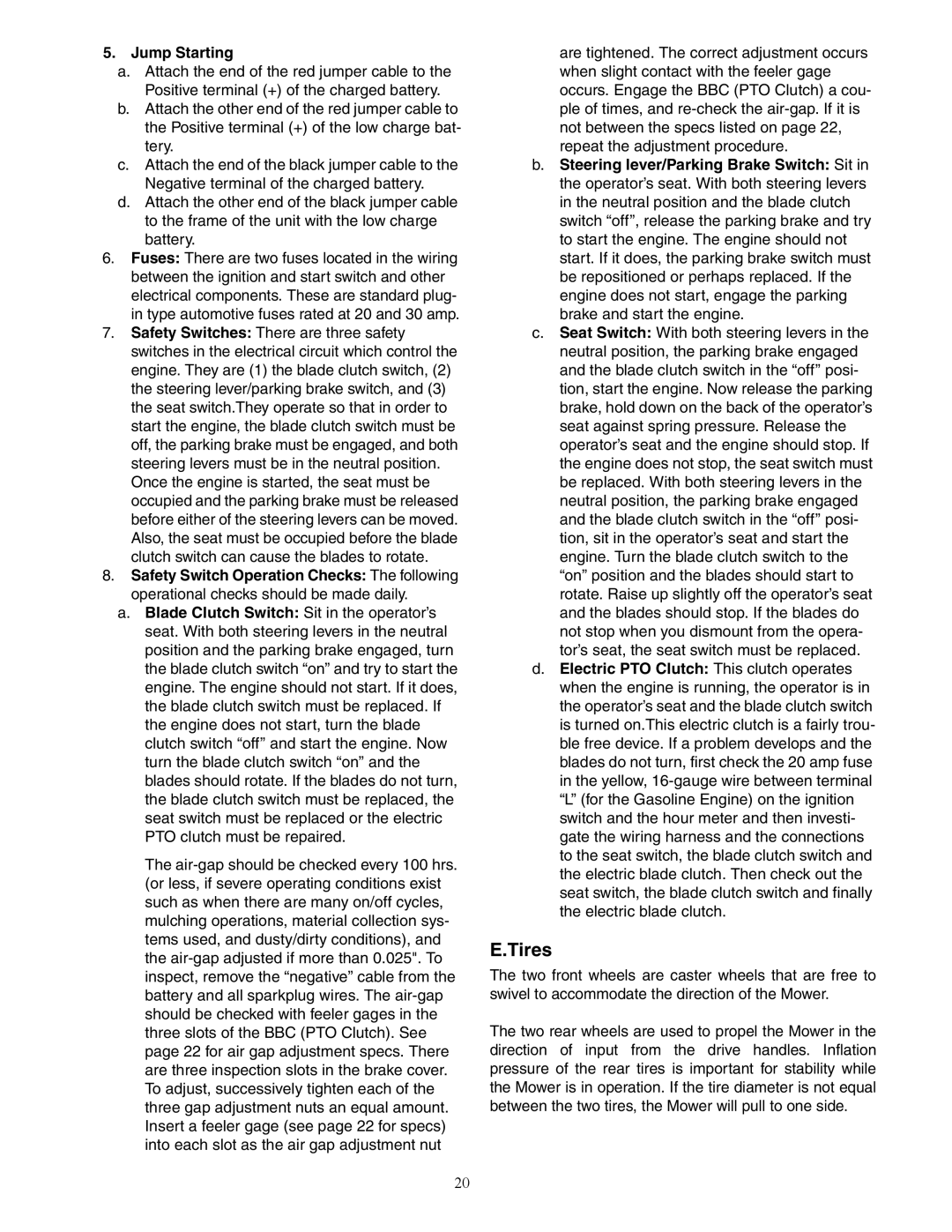5.Jump Starting
a.Attach the end of the red jumper cable to the Positive terminal (+) of the charged battery.
b.Attach the other end of the red jumper cable to the Positive terminal (+) of the low charge bat- tery.
c.Attach the end of the black jumper cable to the Negative terminal of the charged battery.
d.Attach the other end of the black jumper cable to the frame of the unit with the low charge battery.
6.Fuses: There are two fuses located in the wiring between the ignition and start switch and other electrical components. These are standard plug- in type automotive fuses rated at 20 and 30 amp.
7.Safety Switches: There are three safety switches in the electrical circuit which control the engine. They are (1) the blade clutch switch, (2) the steering lever/parking brake switch, and (3) the seat switch.They operate so that in order to start the engine, the blade clutch switch must be off, the parking brake must be engaged, and both steering levers must be in the neutral position. Once the engine is started, the seat must be occupied and the parking brake must be released before either of the steering levers can be moved. Also, the seat must be occupied before the blade clutch switch can cause the blades to rotate.
8.Safety Switch Operation Checks: The following operational checks should be made daily.
a.Blade Clutch Switch: Sit in the operator’s seat. With both steering levers in the neutral position and the parking brake engaged, turn the blade clutch switch “on” and try to start the engine. The engine should not start. If it does, the blade clutch switch must be replaced. If the engine does not start, turn the blade clutch switch “off” and start the engine. Now turn the blade clutch switch “on” and the blades should rotate. If the blades do not turn, the blade clutch switch must be replaced, the seat switch must be replaced or the electric PTO clutch must be repaired.
The
are tightened. The correct adjustment occurs when slight contact with the feeler gage occurs. Engage the BBC (PTO Clutch) a cou- ple of times, and
b.Steering lever/Parking Brake Switch: Sit in the operator’s seat. With both steering levers in the neutral position and the blade clutch switch “off”, release the parking brake and try to start the engine. The engine should not start. If it does, the parking brake switch must be repositioned or perhaps replaced. If the engine does not start, engage the parking brake and start the engine.
c.Seat Switch: With both steering levers in the neutral position, the parking brake engaged and the blade clutch switch in the “off” posi- tion, start the engine. Now release the parking brake, hold down on the back of the operator’s seat against spring pressure. Release the operator’s seat and the engine should stop. If the engine does not stop, the seat switch must be replaced. With both steering levers in the neutral position, the parking brake engaged and the blade clutch switch in the “off” posi- tion, sit in the operator’s seat and start the engine. Turn the blade clutch switch to the “on” position and the blades should start to rotate. Raise up slightly off the operator’s seat and the blades should stop. If the blades do not stop when you dismount from the opera- tor’s seat, the seat switch must be replaced.
d.Electric PTO Clutch: This clutch operates when the engine is running, the operator is in the operator’s seat and the blade clutch switch is turned on.This electric clutch is a fairly trou- ble free device. If a problem develops and the blades do not turn, first check the 20 amp fuse in the yellow,
E.Tires
The two front wheels are caster wheels that are free to swivel to accommodate the direction of the Mower.
The two rear wheels are used to propel the Mower in the direction of input from the drive handles. Inflation pressure of the rear tires is important for stability while the Mower is in operation. If the tire diameter is not equal between the two tires, the Mower will pull to one side.
20
